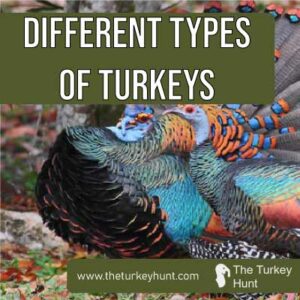The wild turkey is a ground and upland bird that calls North America its’ home. This is where the bird received its name. There are many different types of turkeys within North America, though. If you’re out turkey hunting, you will see a different species of bird depending on the region you are hunting in. A lot of new comers to turkey hunting don’t know this. They simply think ‘a turkey is a turkey’ and they’re no different from each other.
This is not true. Let’s get into the different kinds of turkeys you’ll encounter while hunting.
Different Types of Turkey
The several subspecies of wild turkeys may be distinguished from one another based on their behavior, coloring, and habitat preferences. Some of these birds looks wildly different from one another, while others look pretty similar.
As a turkey hunter, you it is your responsibility to know the different types out there. Different turkeys may call in a different manner, or have different characteristics in how they interact with each other. Knowing the differences will help make your hunt even better.
The following are the six subspecies:
- Eastern Turkey – America
- Rio Grande Turkey – America
- Merriam’s Turkey – America
- Osceola Turkey – America
- Gould’s Turkey – Southwest America & Mexico
- South Mexican Turkey – Mexico
Eastern Wild Turkey
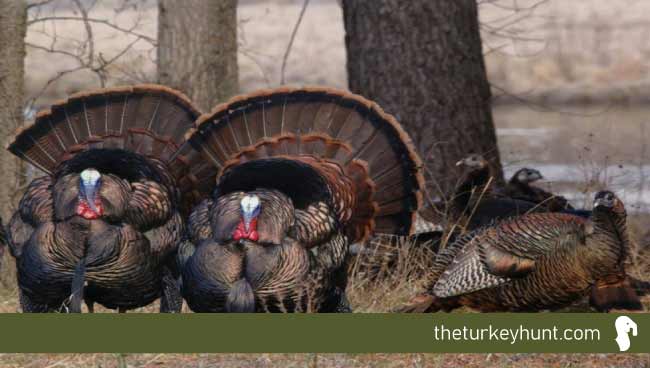
The ‘eastern’ is the one that can be found in the most locations and has the greatest overall population size. They may be found in a total of 38 states and lots of Canadian provinces, however, the majority of their distribution is east of the Mississippi River – hence the name eastern.
Related: Turkey Hunting Videos
They may be identified by the brown tips on the feathers of their tail (tail feathers) as well as the white and black bands that cover their wings. Adult males (aka Toms) weigh between 18 and 30 pounds, while adult females, also known as hens, normally weigh between 8 and 12 pounds. It is generally agreed that the gobbles on eastern toms are the most powerful of all the subspecies. In addition to this, their beards are often the longest of all the subspecies.
You want to nail a massive beard dragger? Try getting yourself an eastern.
Eastern Feathers:
- The tips of the tail feathers have a chestnut brown color.
- The wings have alternating white and black bands.
Eastern Size:
- Male adults weigh between 18 and 30 pounds.
- Female adults weigh between 8 and 12 pounds.
Osceola Wild Turkey
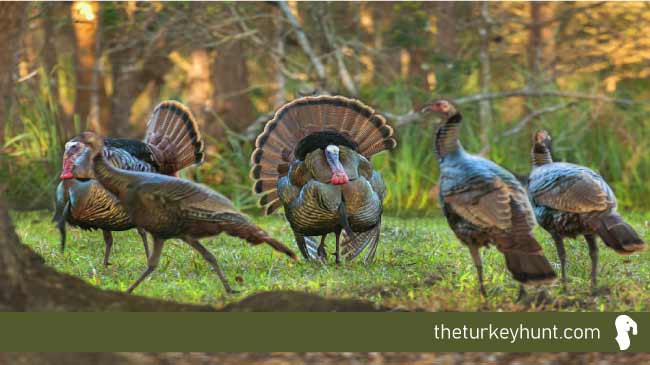
Sometimes they are referred to as the ‘Florida Wild Turkey’ since this is where most of them live. There are around 80,000 – 100,000 birds, according to recent Florida Wildlife studies.
The initial description of this bird was made in the year 1890, and it was given the name Osceola after the legendary Seminole Chief. When compared to the eastern wild turkey, this species is much smaller and darker.
They are often seen in palmetto scrub areas and sometimes quite close to marshes, both of which are rich in amphibian prey. The Osceola turkey is the smallest of the subspecies.
Osceola Feathers:
- Iridescent green and purple coloration may be seen throughout their body feathers
- The wing feathers are very black and have little barring
Osceola Size:
- Male adults weigh between 16 – 18 pounds.
Rio Grande Wild Turkey
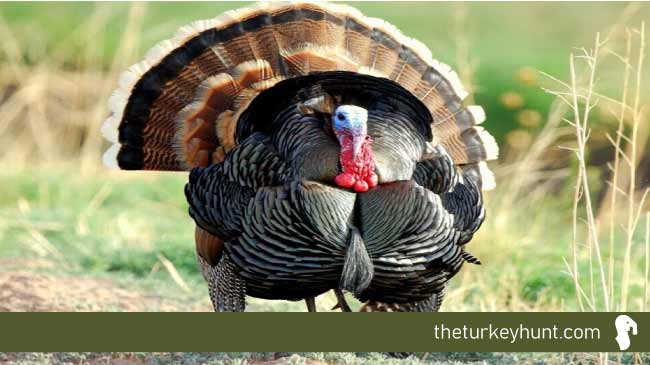
The Rio Grande, or simply ‘Rio’ turkey range extends from Texas through Oklahoma, New Mexico, Kansas, Oregon, Colorado, and Utah. It has also been introduced to sections of central and western California, in addition to a few areas in the northeastern states.
In the late 1950s, it was also brought to Hawai’i for the first time. There are around one million members of this subspecies. It has relatively long legs, making it better suited to the environment of prairies. It makes its home in brushy places close to rivers and streams, as well as in woodlands of mesquite, pine, and scrub oak.
The Rio is known for how talkative they are. If you are looking for a spring gobble fest, seek out a Rio during a spring hunt. You’ll thank me later.
Rio Feathers:
- The body feathers of toms are vibrantly colored: iridescent copper, bronze, red, green, and gold.
Rio Size:
- Male adults weigh between 17 – 21 pounds.
- Female adults weigh between 8 – 11 pounds
Merriam’s Wild Turkey
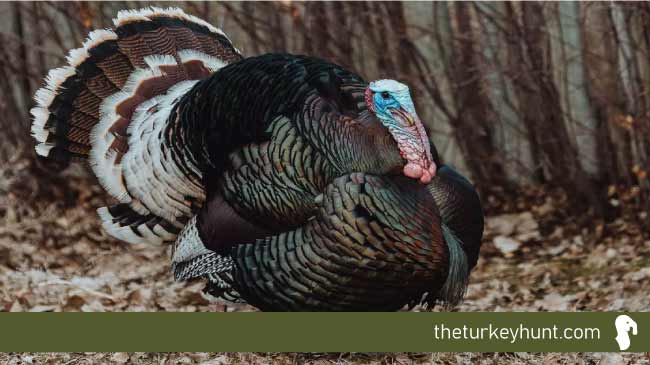
Merriam’s wild turkeys can be found in the Rocky Mountains and the prairies that surround them in Montana, Wyoming, and South Dakota. It also inhabits a significant portion of the high mesa country in New Mexico, Arizona, and southern Utah, as well as the Navajo Nation, and its population is estimated to be between 334,460 and 344,460 birds.
Additionally, the Merriam’s have been brought into the state of Oregon. The first releases of Merriam’s turkeys in 1961 led to the establishment of a residual population of Merriam’s turkeys along the east slope of Mount Hood.
Merriam’s flocks have also been created near the eastern border of Oregon as a consequence of the natural immigration of turkeys from Idaho.
Wild turkeys of Merriam’s subspecies are found in areas with ponderosa pine and steep terrain. In honor of Clinton Hart Merriam, the first head of the United States Biological Survey, the subspecies was given the name Clinton Hart Merriam in the year 1900.
Merriam’s Feathers:
- The males exhibit black-tipped breast feathers, while the females (hens) have buff-tipped breast feathers.
Merriam’s Size:
- Male adults weigh between 14 – 22 pounds.
- Female adults weigh between 8 – 11 pounds
Gould’s Wild Turkey
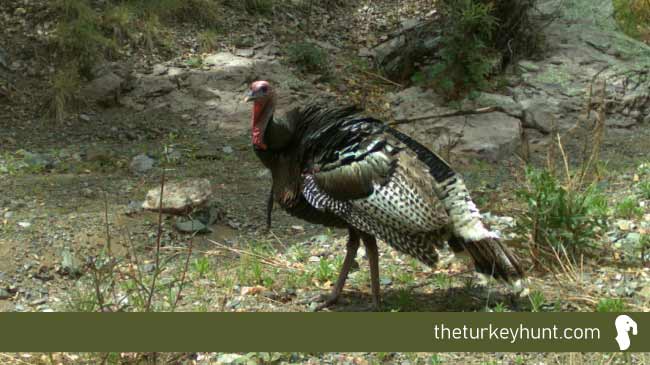
The Gould’s Wild Turkey is a species of wild turkey that is only found in the tiniest of habitats in the southernmost parts of New Mexico and Arizona. Greater populations of the birds may be found in some regions of northern and central Mexico, which is where customers can seek the assistance of outfitters on their quest for a Turkey Hunting Grand Slam.
Although the Gould’s Wild Turkey, the biggest of the species, its coloring and feathering are similar to those of the Merriam’s.
It is believed that there are less than one thousand Gould’s Wild Turkeys living in their natural habitat in the United States.
Gould’s Feathers:
- The males exhibit black-tipped breast feathers, while the females (hens) have buff-tipped breast feathers.
Gould’s Size:
- Male adults weigh between 18 – 30 pounds.
- Female adults weigh between 8 – 12 pounds
South Mexican (Ocellated) Wild Turkey
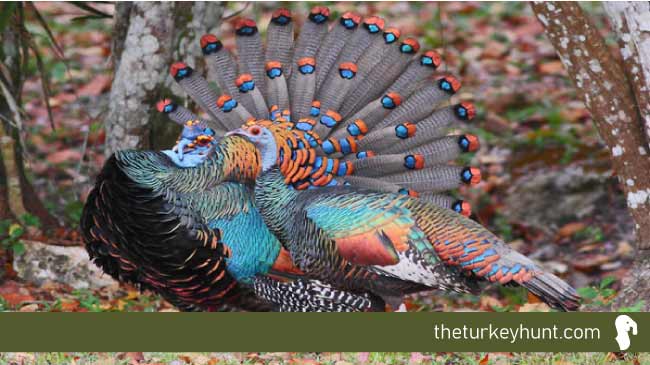
No, this is not a peacock. This is the fabled Ocellated turkey of South Mexico. These birds resemble a traditional turkey in shape, but they take on some wild coloring patterns, as you can see.
What they lack for in size, they make up for in color.
As of the year 2010, it was believed that the south Mexican wild turkey was either extinct or on the verge of extinction. The south Mexican wild turkey is one of the smallest subspecies of wild turkeys. If it were seen anywhere in Mexico, it would only be in the central region.
It is not present in either the United States or Canada.
Ocellated Feathers:
- Both males and females defy all other forms of turkey coloring. Expect to see several forms of neon blue, orange, with hints of green throughout.
Ocellated Size:
- Male adults weigh between 10-14 pounds.
- Female adults weigh between 6-8 pounds
Different Turkeys = Different Hunts
Different turkeys can bring different hunting experiences for you. For example, did you know that the Rio turkey is a very, very vocal species of turkey? This means that you are more likely to have success when calling back and forth, when compared to an ocellated turkey which may not give any calls at all.
Also, the different types of birds occupy different regions of America. This will mean your terrain is vastly different – depending on your bird species. Different terrain and weather means you need to reconsider your turkey hunting gear.
Different regions also experience different weather. Take this example: a fall hunt for the Osceola bird in Florida will be WAY WAY warmer than a fall hunt for Rio in Northern Texas. Be sure to wear appropriate clothing.
Summary – Different Kinds of Turkeys in North America
That concludes our article on the different types of turkeys that can be found in North America. Knowing your species of bird will help you on your hunt. With so many species to add to your kill list, it sure makes the fun of turkey hunting last a lot longer than some other types of hunts.
It benefits hunters to know the behaviors of their birds, how the call, if they are social or not, roosting preferences, etc… The better you understand what you’re hunting for, the more likely you are to have a successful hunt.

